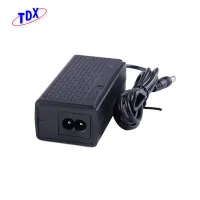A Practical Guide to Desktop Power Adapters: What They Are and How to Choose the Right One
Desktop power adapters are essential components in countless electronic devices—from routers and monitors to medical equipment and industrial instruments. While they may look simple on the outside, choosing the right adapter (and replacing it correctly) is critical for safety, performance, and device longevity. This guide explains what a desktop power adapter is, how to choose the correct model, key specifications to understand, and how they differ from laptop chargers.
What Is a Desktop Power Adapter?
A desktop power adapter, often referred to as an external power supply or AC-DC adapter, is a standalone device that converts high-voltage AC power from wall outlets into low-voltage DC power required by electronic equipment.
Unlike wall-mount adapters that plug directly into the socket, desktop adapters are larger units with a separate AC input cable, making them suitable for:
Computers and monitors
Networking equipment
POS devices
Medical instruments
Industrial control systems
Consumer electronics
Desktop adapters are typically designed to deliver higher wattages, better heat dissipation, and more stable output than simple wall-plug models.
How to Choose the Right Desktop Power Adapter
Selecting a compatible and safe adapter requires evaluating several key parameters:
1. AC Input Voltage
Modern desktop adapters usually support a universal input range of 90–264 VAC, covering the majority of global power systems.
North America: 110–120 VAC
Europe & Asia: 220–240 VAC
Specialized applications (e.g., medical, lighting) may require input tolerance beyond standard ranges.
Always verify the expected input environment before choosing an adapter.
2. DC Output Voltage
Most devices require a specific DC voltage, typically 3.3 VDC to 56 VDC.
You must match:
The required voltage exactly
The polarity (most devices use center-positive)
Using an incorrect voltage may cause malfunction or permanent damage.
3. Power Rating (Watts)
One of the most important—yet most commonly overlooked—specifications.
The adapter’s wattage must be equal to or greater than the device’s power consumption.
Underrated adapters can lead to overheating, reduced lifespan, or complete failure.
Check the device’s rated power and ensure a suitable margin.
4. Efficiency Rating
In many countries, external power supplies must comply with strict energy efficiency standards.
In the U.S., adapters must meet DOE Level VI requirements.
In the EU, similar regulatory standards apply.
Adapters usually display an efficiency mark, such as VI inside a circle.
5. Connectors
Choosing the correct connector involves specifying:
Outer diameter
Inner diameter
Length
Polarity
Barrel connectors are most common, but DIN, Molex, and custom connectors are also widely used.
6. Safety Certifications
Power adapters must meet regional and application-specific standards such as:
UL, FCC (U.S.)
CE (Europe)
Medical certifications (IEC 60601)
Industrial certifications (IEC 62368 / 60950)
Always confirm that the adapter’s certifications align with the intended market and device type.
Desktop Power Supply Replacement Guide
If your desktop adapter is lost, damaged, or no longer functioning, follow these steps to replace it safely:
1. Identify the Required Voltage and Current
Check the label on your original adapter or the device input panel.
You must match:
Voltage (V)
Polarity
Current (A) can be higher than required, but never lower.
2. Match the Connector Type
Measure or check the documentation for barrel size or choose the correct alternative connector type.
3. Confirm Wattage
Calculate:
Watts = Voltage × Amperage
Choose an adapter with at least this wattage.
4. Verify Certifications
For example:
Medical devices require medical-grade supplies.
Consumer devices typically require IEC 62368-1 compliance.
5. Avoid Low-Quality or Uncertified Alternatives
Cheap, uncertified adapters can pose risks like:
Overheating
Fire hazards
Electromagnetic interference
Device failure
Whenever possible, replace with an OEM-approved or high-quality third-party equivalent.
Desktop Power Adapter Specifications Explained
When reviewing a datasheet or purchasing a replacement, these specifications matter most:
| Specification | Meaning |
|---|---|
| Input Voltage | The AC range the adapter can accept |
| Output Voltage | The DC voltage delivered to the device |
| Output Current | Maximum current for stable operation |
| Power Rating (W) | Maximum output power |
| Efficiency Level | DOE, EU CoC Tier 2, etc. |
| Ripple and Noise | Stability of output voltage |
| Operating Temperature Range | Maximum safe ambient temperature |
| Derating Curve | Power limitations at higher temperatures |
| Connector Type / Polarity | Barrel size, DIN, etc. |
| Safety Certifications | UL, CE, medical, industrial |
Understanding these details ensures full compatibility and prevents failures.
Laptop Charger vs Desktop Power Adapter: What’s the Difference?
Although they look similar, they are built for different purposes.
| Feature | Laptop Charger | Desktop Power Adapter |
|---|---|---|
| Primary Use | Powering/charging laptops | Powering external electronics |
| Output Type | Typically one fixed high voltage (e.g., 19V) | Wide range (3.3–56V), single or multiple |
| Power Range | 45–240W | 10–300W or more |
| Connector | Proprietary or USB-C PD | Barrel plugs, DIN, custom |
| Function | Charges battery + powers device | Powers device only |
| Complexity | Intelligent communication for charging | Simple constant voltage output |
Laptop chargers often include additional logic (USB-C PD negotiation, proprietary protocols), while desktop adapters focus on stable, regulated DC power delivery.
Conclusion
Desktop power adapters may seem like basic accessories, but selecting the correct one is essential for safe and reliable operation. By understanding key parameters such as output voltage, wattage, connector type, efficiency, and certifications, you can confidently choose or replace an adapter for nearly any device.



Comments
0